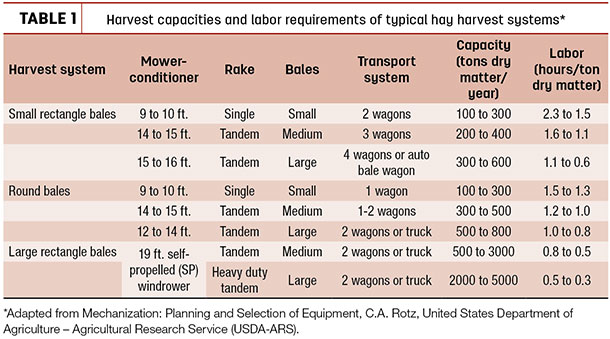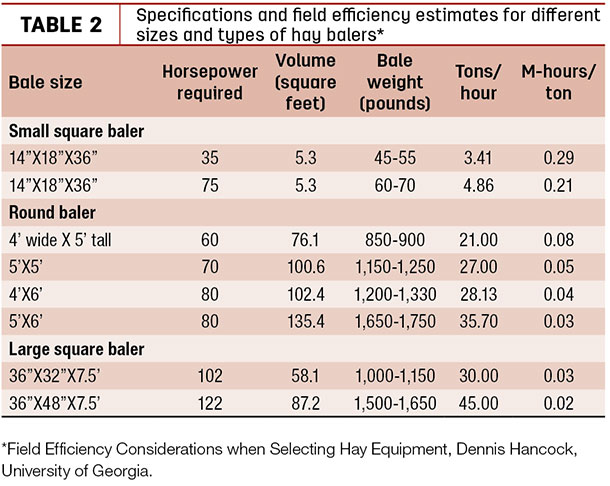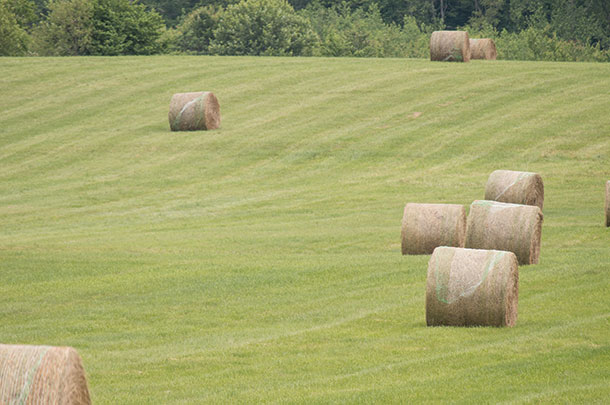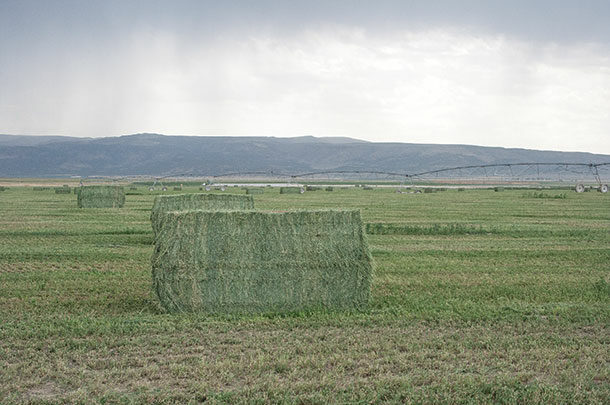Taking sufficient time to choose the right machinery for the particular forage operation is a key task for producing hay economically.
Usually, the first consideration in any purchase is price; however, value relevant to cost should also be evaluated. It is very important that equipment is suitable for the size of the operation and that it will match other hay harvesting equipment on hand. Data shown in Table 1 can help in making these determinations.

“Wise machinery selection requires an evaluation of crop conditions and capacity requirements,” says Dennis Buckmaster, Ph.D., Purdue University. “Sometimes it boils down to personal preferences, dealer inventory and service. A visit with a knowledgeable salesperson is often required for making the right choice. Properly match tractors to mowers, rakes and balers by studying sales literature or operator’s manuals.”
“Hay balers are used to compress and package hay for easier handling,” says Alan Rotz, Ph.D., USDA – Agricultural Research Service.
“Hay balers are available that produce bales of many sizes and shapes. Advantages and disadvantages are associated with each. Small rectangular bales, often referred to as square bales, have been the most popular over the past 50 years. Now, large round and rectangular bales are becoming the dominant hay packages."
"Harvest systems are sometimes used to produce small round bales, low-density stacks and cubes, but these constitute a relatively small portion of the hay produced.”
When considering hay balers, determine desired package shape and size for the targeted user before making a choice. Amount of hay that will be harvested on an annual basis is an important factor in selection of hay harvest equipment. Once the number of acres and cuttings are determined, comparisons of field efficiency of various baler brands and models can be made.
According to Buckmaster, there are four factors that can limit production of any agricultural machine: power, throughput capacity, speed and traction. Power may be limited when a high-capacity baler is used with a 75 hp tractor harvesting a high-yield windrow.
Throughput capacity is limited when a high-yield windrow is harvested with a relatively low-capacity twine-tie baler pulled with a 140 hp tractor.
A high-capacity baler with a suitable sized tractor harvesting a low-yield windrow results in a speed- limited situation. You can only drive so fast before pickup lags. The way to remedy this problem is to rake two windrows together.
Round balers
“Large round bale packaging systems allow one person to harvest and store large quantities of hay,” says John Slocombe, Ph.D., Kansas State University. “However, a large round baler requires specific management practices to maintain hay quality and minimize loss during harvest, transportation and storage.
“Power required for a large round baler varies with the size of baler, size and density of the bale, rate of forming and contour of the field,” Slocombe adds. “As a rule of thumb, the smallest balers require at least 40 horsepower and the largest balers require 100 horsepower or more (Table 2)."

"For safety reasons, the most important consideration when matching a tractor to a round baler is tractor size, not horsepower. The gross weight of the tractor must be greater than that of the gross weight of the fully loaded baler. This weighting scheme allows the tractor to maintain control of the baler even when operating on slopes.”
Cost per hour ($/hour) to operate a round baler is about the same whether the baler is operated at 60 percent of design capacity (ton/hour throughput) or 90 percent. Cost per bale is calculated as:
Baling cost ($/ton) = Cost to operate ($/hour) ÷ Throughput (ton/hour)
There are cost advantages in operating a baler at maximum design capacity; however, other factors need to be considered. Operators must learn not to drive too fast along a heavy windrow. If a baler becomes jammed, it may take 30 minutes or longer to correct this problem. Most balers are equipped with a slip clutch on the pickup mechanism.
As the slip clutch is engaged due to overloading, the operator can hear the noise and knows to slow down forward progress. Most operators need to keep the baler operating at 90 percent of design capacity to obtain maximum efficiency.
“Most large round balers are designed to minimize hay loss, which makes them more efficient,” says Slocombe. “A typical system will have a dedicated bale chamber and very close belt spacing. The chamber can be fixed or variable. In a fixed chamber baler, hay is collected and rolled inside the chamber until it is full.

The bale is then wrapped, tied and ejected. These bales tend to have a soft core. Internal working parts of the fixed chamber are normally belts, chains, rollers or drums.
“In a variable chamber, flat belts or chains with slats contain the bale from its initial formation until completion, and can make a bale with uniform density. Some round baler models have twin bale chambers.
In one chamber, formation of a new bale begins while a bale is being wrapped, tied and ejected from the second chamber. All of these operations occur without stopping the forward travel of the tractor.
“Data suggests that hay losses are lower for variable chamber balers with belts than for fixed chamber balers with rollers,” says Slocombe. “However, rollers may require less maintenance than belts or chains.
“Large round balers come in a wide range of sizes. The smallest balers produce a full-sized bale that is approximately 4 feet wide by 5 feet in diameter. The largest balers make bales that are 8 feet wide by 6 feet in diameter. Bale weights vary from 500 to 2,500 pounds in properly conditioned hay. Bale weights also vary with type and species of forage and cutting time (first, second or third).”
Mini-round balers, also called roto-balers, are available for people with a small number of acres on which to produce hay. The compact round baler works on the same principle as its bigger cousin, rolling the hay inside a chamber until it reaches a certain size, then wrapping the bale with either twine or net, and ejecting it out the rear of the machine.
A mini-round bale generally weighs 40 to 55 pounds and can be easily lifted by one person.
Square balers
“The small rectangular bale is about 14 by 16 inches in cross section with lengths up to 50 inches,” says Rotz. “An advantage of small rectangular bales is that the 55- to 75-pound bale can be manually handled in stacking and feeding. A disadvantage is that this bale handling is labor-intensive."
"During a typical baling operation where hay is transported and stacked in storage simultaneous with baling, up to five people are required. A relatively small tractor of 35 to 60 horsepower is sufficient to power small rectangular balers.”
Rotz says large rectangular, high-density bales are becoming more popular, particularly for hay transported long distances. These bales have a height and width of 23 to 50 inches, a length of 47 to 98 inches and a weight of 400 to 2,200 pounds. Special equipment is thus needed for lifting, transporting and feeding these large bales.
Balers producing these large packages offer greater baling capacity as they are capable of harvesting twice the amount of hay per hour as the small-package balers. More power is required with a minimum tractor size of 120 horsepower recommended for the largest balers.
As with round balers, make sure you know the specifications of your tractor before you shop for rectangular balers. Its horsepower rating and weight are the most important specifications, but in some cases you may need to know the width or other details. Your tractor’s manual should have this information.
Basically, baler selection should be based on desired shape and size of the bale, amount of hay to be harvested and size and capacity of other owned hay-harvesting equipment. ![]()
PHOTO 1: Big bales. Photo by Robert Fears.
PHOTO 2: Round bales. Photo by Lynn Jaynes.

-
Robert Fears
- Freelance Writer
- Based in Georgetown, Texas











